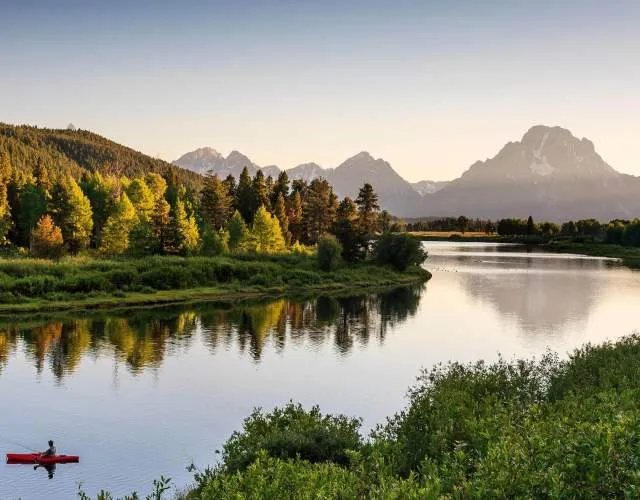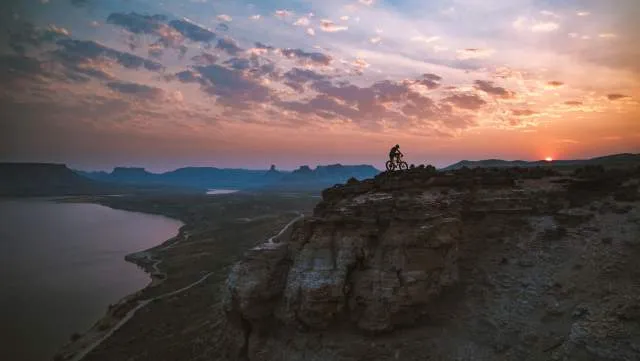Planning a trip to Wyoming is an exciting venture into the heart of the American West. Known for its breathtaking landscapes, iconic national parks, and rich cowboy culture, the Equality State offers adventures both grand and intimate. However, exploring a destination as wild and expansive as Wyoming requires thoughtful preparation. Beyond just picking your destinations like Yellowstone or Grand Teton National Parks, understanding the unique aspects of traveling here is key to a smooth and unforgettable experience.
If you’re accustomed to traveling to destinations like California with extensive public transport or highly predictable weather patterns, Wyoming presents a different kind of preparation challenge. This article will guide you through the essential steps on what to prepare for traveling to Wyoming, covering everything from packing essentials to understanding the local environment and maximizing your experience.
Understanding Wyoming’s Climate and Terrain
Wyoming’s weather can be notoriously unpredictable, often changing rapidly within a day. Elevations vary dramatically across the state, from high mountain peaks to vast sagebrush plains, influencing local conditions. Understanding the typical climate for your chosen travel season is fundamental when considering what to prepare for traveling to Wyoming. Summers are generally warm but can have cool evenings and sudden thunderstorms. Winters are cold with significant snowfall, particularly at higher elevations, impacting road travel and access to certain areas. Spring and fall offer beautiful scenery but are highly variable regarding temperature and precipitation.
Packing Essentials: More Than Just Clothes
Packing for a Wyoming trip means being prepared for a range of activities and weather conditions. Layering is crucial regardless of the season. Include moisture-wicking base layers, insulating mid-layers like fleece or down, and a waterproof/windproof outer shell. Even in summer, warm layers are necessary for early mornings, evenings, and higher altitudes. Sturdy hiking boots or shoes are essential for exploring trails. Don’t forget sun protection – sunscreen, a wide-brimmed hat, and sunglasses – as the sun is strong, especially at higher elevations. Insect repellent is also highly recommended, particularly during warmer months near water sources.
 Wide Open, Since 1890 Grand Teton National Park in the northwest of the state of WyomingAlt text: Scenic view of Grand Teton National Park, highlighting the vast landscapes when preparing for traveling to Wyoming.
Wide Open, Since 1890 Grand Teton National Park in the northwest of the state of WyomingAlt text: Scenic view of Grand Teton National Park, highlighting the vast landscapes when preparing for traveling to Wyoming.
For photographers, extra batteries and memory cards are a must to capture the stunning scenery and wildlife. Binoculars are invaluable for wildlife viewing, a highlight of any Wyoming adventure. A reusable water bottle is essential for staying hydrated; consider a water filter or purification tablets if planning backcountry excursions. Always pack a basic first-aid kit, including pain relievers, blister treatment, and any personal medications. These items are key components of what to prepare for traveling to Wyoming to ensure comfort and safety.
Getting Around: Navigating the Cowboy State
Wyoming is a state of vast distances, and a car is almost always necessary for independent travel. Roads are generally well-maintained, but conditions can change rapidly with weather, especially in winter. Planning your route in advance and checking road conditions is vital. Fill up your gas tank whenever you see a station, especially when driving through rural areas, as services can be sparse. Download offline maps or carry physical maps, as cell service is not guaranteed everywhere. For those wondering what to prepare for traveling to Wyoming regarding transportation, renting a vehicle is usually the most practical option.
Consider the type of vehicle you’ll need based on your itinerary. If you plan to explore national forests or engage in off-road adventures, a high-clearance or four-wheel-drive vehicle might be beneficial. Be aware of speed limits on rural highways and watch out for wildlife crossing roads, particularly at dawn and dusk. Allow extra time for travel between destinations due to the size of the state and potential weather delays.
National Parks and Recreation Passes
Wyoming is home to two of the most famous National Parks in the United States: Yellowstone and Grand Teton. Entry to these parks requires a fee. If you plan to visit multiple national parks or federal recreation sites within a year, purchasing an America the Beautiful Pass might be a cost-effective part of your preparations for traveling to Wyoming. These passes cover entrance fees at national parks and national wildlife refuges and standard amenity fees at national forests and grasslands.
Research the specific operating seasons and reservation requirements for the parks you plan to visit. Popular areas within Yellowstone and Grand Teton, like the drive to Jenny Lake or accessing certain trailheads, may require timed entry reservations during peak season. Booking lodging and activities well in advance is also strongly advised, as accommodations, especially within or near the national parks, fill up quickly.
Fun Things to Do in Kissimmee Florida
Where To Go In Waikiki – Your Ultimate Guide to Hawaii’s Iconic Beachfront
The Best Things to Do in Naples – Your Ultimate Italian Experience
 Family hiking in rugged landscapeAlt text: A family hiking during sunset, enjoying the rugged landscape, a common activity when preparing for traveling to Wyoming.
Family hiking in rugged landscapeAlt text: A family hiking during sunset, enjoying the rugged landscape, a common activity when preparing for traveling to Wyoming.
Wildlife Safety and Etiquette
Encountering wildlife is a highlight of visiting Wyoming, but it’s crucial to do so safely and respectfully. Bears, moose, bison, and elk are common, particularly in and around the national parks. Maintain a safe distance from all animals; the general rule is at least 25 yards (23 meters) for most wildlife and 100 yards (91 meters) for bears and wolves. Never feed wildlife.
Carry bear spray and know how to use it if you plan on hiking in bear country. Make noise while hiking to avoid surprising animals. Secure food properly, especially when camping. Familiarize yourself with park regulations and guidelines regarding wildlife encounters. Respecting the natural environment and its inhabitants is a vital part of what to prepare for traveling to Wyoming responsibly.
Altitude and Hydration
Many popular destinations in Wyoming, including Yellowstone and Grand Teton, are at high altitudes. Visitors from lower elevations may experience altitude sickness. Symptoms can include headache, nausea, dizziness, and fatigue. To minimize the risk, stay hydrated, avoid alcohol and strenuous activity on your first day, and allow your body time to adjust.
Drinking plenty of water is essential not only for altitude but also because Wyoming has a dry climate. Dehydration can happen quickly, especially when engaging in outdoor activities. Carry water with you at all times and drink frequently. Staying hydrated is a simple yet critical step on what to prepare for traveling to Wyoming.
Connectivity and Communication
While major towns and popular tourist spots have reliable cell service and internet access, many remote areas in Wyoming do not. Be prepared for periods without connectivity, especially when exploring vast wilderness areas or driving on less-traveled roads. Inform someone of your travel plans, including your route and expected return time.
Consider carrying a satellite communicator or personal locator beacon (PLB) if you plan on extensive backcountry hiking or remote camping. These devices can be lifesavers in emergencies where traditional communication methods are unavailable. Packing physical maps and downloading offline digital maps can help you navigate without relying on cell service.
Booking Accommodation and Activities in Advance
Wyoming’s popularity, particularly during peak summer season, means that accommodation and popular activities book up months in advance. Whether you’re looking for hotels, lodges, campgrounds, or guided tours, it’s highly recommended to make reservations as early as possible. Spontaneous travel is more challenging during the busiest times.
Research different lodging options, from luxury resorts to rustic cabins and campsites, based on your budget and desired experience. Check cancellation policies when booking. Planning and booking your key stops and activities is a fundamental step in what to prepare for traveling to Wyoming successfully.
 Default Header – OutdoorsAlt text: A serene outdoor scene in Wyoming, showing mountains and a body of water, highlighting the adventure of traveling to Wyoming.
Default Header – OutdoorsAlt text: A serene outdoor scene in Wyoming, showing mountains and a body of water, highlighting the adventure of traveling to Wyoming.
Be Informed, Be Smart, Be Responsible
The original article correctly highlights the importance of being informed, smart, and prepared. Beyond the practical aspects, this also includes understanding and respecting the local culture and environment. Wyoming has a strong Western heritage; interacting with locals can provide valuable insights and enrich your trip.
Familiarize yourself with Leave No Trace principles to minimize your impact on the natural environment. Pack out everything you pack in, stay on designated trails, and dispose of waste properly. Respect private property and follow all posted signs. Traveling responsibly ensures that Wyoming’s natural beauty remains preserved for future visitors.
Beyond the Parks: Exploring Wyoming’s Diversity
While the National Parks are major draws, preparing for traveling to Wyoming should also include researching other attractions. The state offers diverse experiences, from exploring state parks and national forests to visiting historic sites, experiencing rodeo culture, and discovering local food and drink scenes.
Consider adding stops in charming towns, exploring scenic byways, or experiencing local events and festivals (like the numerous rodeos highlighted in the original text). Each region of Wyoming offers unique landscapes and activities. Researching these options beforehand allows you to tailor your trip to your interests and discover the less-traveled paths the state offers.
 Cyclist riding along a dirt trail with views of Flaming Gorge in Sweetwater County, Wyoming.Alt text: Cyclist on a dirt trail overlooking Flaming Gorge, an example of outdoor activities to prepare for traveling to Wyoming.
Cyclist riding along a dirt trail with views of Flaming Gorge in Sweetwater County, Wyoming.Alt text: Cyclist on a dirt trail overlooking Flaming Gorge, an example of outdoor activities to prepare for traveling to Wyoming.
Frequently Asked Questions About Traveling to Wyoming
Planning a trip often brings up specific questions. Here are some common ones regarding what to prepare for traveling to Wyoming:
- What is the best time of year to visit Wyoming? Summer (June to August) is most popular for warm weather and full access, but spring and fall offer fewer crowds and beautiful scenery (with variable weather). Winter is ideal for snow sports but requires extensive preparation for cold and road closures.
- Do I need a car in Wyoming? For most travelers, yes. Distances are large and public transport is limited outside of city centers.
- Is altitude sickness a concern? Yes, especially if visiting areas like Yellowstone or Grand Teton. Stay hydrated and take it easy on your first day.
- How should I prepare for wildlife encounters? Maintain distance, never feed animals, carry bear spray in bear country, and be aware of your surroundings, especially when hiking.
- What should I pack for a summer trip to Wyoming? Layers are key: moisture-wicking base layer, fleece or light jacket, waterproof/windproof outer layer, sturdy hiking shoes, hat, sunglasses, sunscreen, insect repellent, reusable water bottle, basic first-aid kit.
Conclusion
Traveling to Wyoming is an adventure filled with incredible natural beauty and rich cultural experiences. By taking the time to research and prepare adequately, you can ensure your trip is safe, comfortable, and truly unforgettable. From packing the right gear and understanding the unique environment to planning your transportation and respecting the local wildlife and culture, knowing what to prepare for traveling to Wyoming is the first step toward forging your own way in the last bastion of the West. Get ready to immerse yourself in the majestic landscapes and abundant experiences that await you.
